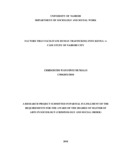| dc.description.abstract | Globally, trafficking on humans is calmed to be one of the most profitable illicit trades
after drugs and firearms trafficking. It generates billions of dollars annually. More than
2.5 million individuals annually are compelled to perform tasks that are undignified
which frequently resulting from human trafficking. It continues to grow at an alarming
rate hence a concern at all levels. It is estimated that 137 countries are involved in human
trafficking. Existing studies have investigated human trafficking in Kenya as a country of
origin as well as transit. This study investigated human trafficking in Kenya as a country
of destination. The study sought to develop the profiles of trafficked persons; factors that
facilitate trafficking of humans to Nairobi; the context from which victims of human
trafficking are pushed; and to establish the modus operandi of the human trafficking into
Nairobi. The study reviewed the literature on factors that motivate human trafficking,
characteristics of victims, the push factors, alluring factors. The study used rational
choice theory and modern slavery theory. The research site was Nairobi city particularly
Pangani police station and Nairobi Remand Home where victims of human trafficking
were found. The study adopted a qualitative design with a limited quantitative
application. Due to the fluidity of the primary respondents, convenient sampling was
used. Therefore a census was undertaken as all the victims of trafficking found and
willing were interviewed. The primary method of data collection was key informant
interviews with police, probation and prisons officers. Approximately, 36 human
trafficking victims were interviewed in two institutions. Key findings were: most victims
were young people aged between 19-25 years, they had a low level of education.
Travelled within a short time from origin to destination, a few had prior employment
experience, most of the victims were not married, there was no significant gender
difference between them, all had originated from Ethiopia and Somalia, and all came to
Nairobi by road. Open borders, ethnic groups straddling border areas, collusion by
motorists and police officers manning roads were the main facilitating factors for entry
into Nairobi. The alluring factors were: the promise of employment, the promise of safety
and better wages. The modus operandi was characterised by particular routes that
seemed favourable, the introduction of victims to a trafficker, little knowledge of a
person in the destination, promises of employment which were often false. The
recommendations were: law enforcement officers on the roads must combat human
trafficking; regional governments need to network better on the borders to control the
trade, introduction of human trafficking in the school curriculum, creation of public
awareness, implement anti-corruption measures along the identified conduit roads. | en_US |



